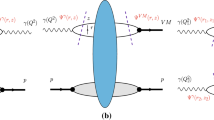Abstract
We consider inelastic proton–proton interactions at high energies in transverse spatial coordinates. Colliding hadrons are represented as ensembles of color dipoles. We use prescriptions of the M¨uller dipole cascade model for the elementary interaction probability. Multiparton interactions are taken into account in the framework of the eikonal approach. We consider two variants of the model, namely, with and without confinement taken into account. We obtain the asymptotic form of the collision profile function for large impact parameters. We use the considered approach to find the slope of the diffraction cone in elastic pp scattering at high energies and compare our results with other models describing profile functions and with the experimental data.
Similar content being viewed by others
References
L. McLerran and R. Venugopalan, Phys. Rev. D, 49, 2233–2241 (1994); arXiv:hep-ph/9309289v1 (1993).
L. McLerran and R. Venugopalan, Phys. Rev. D, 49, 3352–3355 (1994); arXiv:hep-ph/9311205v2 (1993).
T. Sjostrand and P. Z. Skands, JHEP, 0403, 053 (2004).
M. Diehl, D. Ostermeier, and A. Schäfer, JHEP, 1203, 089 (2012); arXiv:1111.0910v2 [hep-ph] (2011).
A. Krasnitz and R. Venugopalan, Nucl. Phys. A, 698, 209–216 (2002); arXiv:hep-ph/0104168v1 (2001).
A. Ortiz Velasquez, P. Christiansen, E. Cuautle Flores, I. A. Maldonado Cervantes, and G. Paić, Phys. Rev. Lett., 111, 042001 (2013); arXiv:1303.6326v2 [hep-ph] (2013).
M. Floris, J. Phys.: Conf. Ser., 270, 012046 (2011).
G. Gustafson, Acta Phys. Polon. B, 40, 1981–1996 (2009); arXiv:0905.2492v1 [hep-ph] (2009).
K. D. Anderson, D. A. Ross, and M. G. Sotiropoulos, Phys. Lett. B, 380, 127–133 (1996); arXiv:hep-ph/9602275v2 (1996).
G. Altarelli and G. Parisi, Nucl. Phys. B, 126, 298–318 (1977).
F. Gelis, E. Iancu, J. Jalilian-Marian, and R. Venugopalan, Ann. Rev. Nucl. Part. Sci., 60, 463–489 (2010); arXiv:1002.0333v1 [hep-ph] (2010).
H. Weigert, Prog. Part. Nucl. Phys., 55, 461–565 (2005); arXiv:hep-ph/0501087v1 (2005).
A. H. Mueller, Nucl. Phys. B, 415, 373–385 (1994).
A. H. Mueller and G. P. Salam, Nucl. Phys. B, 475, 293–317 (1996); arXiv:hep-ph/9605302v1 (1996).
V. V. Vechernin, I. A. Lakomov, and A. M. Puchkov, Vestn. Peterb. Univ. Ser. 4: Fiz. Khim., No. 3, 3–16 (2010).
M. A. Braun and V. V. Vechernin, J. Phys. G, 16, 1615–1626 (1990).
E. Avsar, G. Gustafson, and L. Lonnblad, JHEP, 0712, 012 (2007); arXiv:0709.1368v3 [hep-ph] (2007).
C. Flensburg, G. Gustafson, and L. Lonnblad, Eur. Phys. J. C, 60, 233–247 (2009); arXiv:0807.0325v1 [hep-ph] (2008).
M. Rybczynski and Z. Wlodarczyk, J. Phys. G, 41, 015106 (2013); arXiv:1307.0636v1 [nucl-th] (2013).
M. A. Braun and V. V. Vechernin, Theor. Math. Phys., 139, 766–786 (2004).
I. M. Dremin and V. A. Nechitailo, Nucl. Phys. A, 916, 241–248 (2013); arXiv:1306.5384v2 [hep-ph] (2013).
V. A. Schegelsky and M. G. Ryskin, Phys. Rev. D, 85, 094024 (2013); arXiv:1112.3243v2 [hep-ph] (2011).
V. Vechernin and I. Lakomov, PoS (Baldin ISHEPP XXI), 072 (2012); arXiv:1212.2667v1 [nucl-th] (2012).
V. N. Kovalenko, Phys. Atom. Nucl., 76, 1189–1195 (2013); arXiv:1211.6209v2 [hep-ph] (2012).
V. Kovalenko and V. Vechernin, PoS (Baldin ISHEPP XXI), 077 (2012); arXiv:1212.2590v1 [nucl-th] (2012).
V. Kovalenko, PoS (QFTHEP 2013), 052 (2013).
Author information
Authors and Affiliations
Corresponding author
Additional information
Translated from Teoreticheskaya i Matematicheskaya Fizika, Vol. 184, No. 3, pp. 465–474, September, 2015.
Rights and permissions
About this article
Cite this article
Kovalenko, V.N. Dipole-based description of the pp interaction. Theor Math Phys 184, 1295–1303 (2015). https://doi.org/10.1007/s11232-015-0337-4
Published:
Issue Date:
DOI: https://doi.org/10.1007/s11232-015-0337-4




